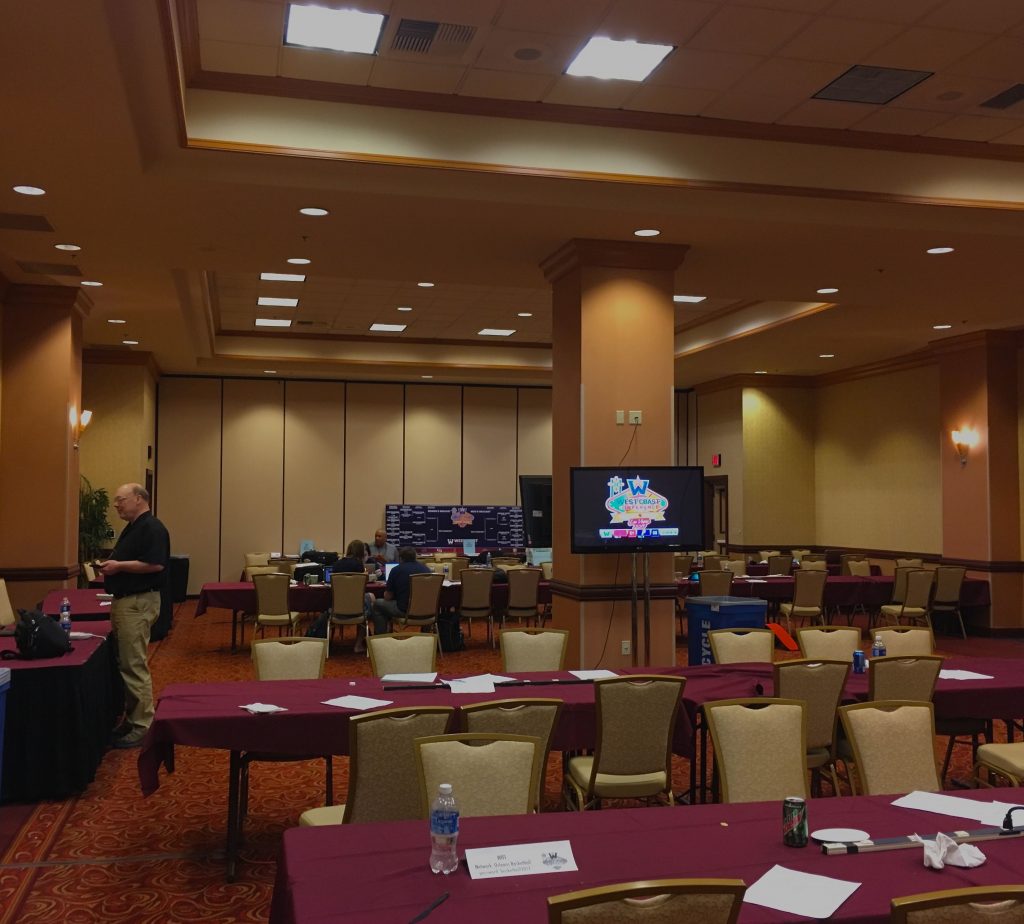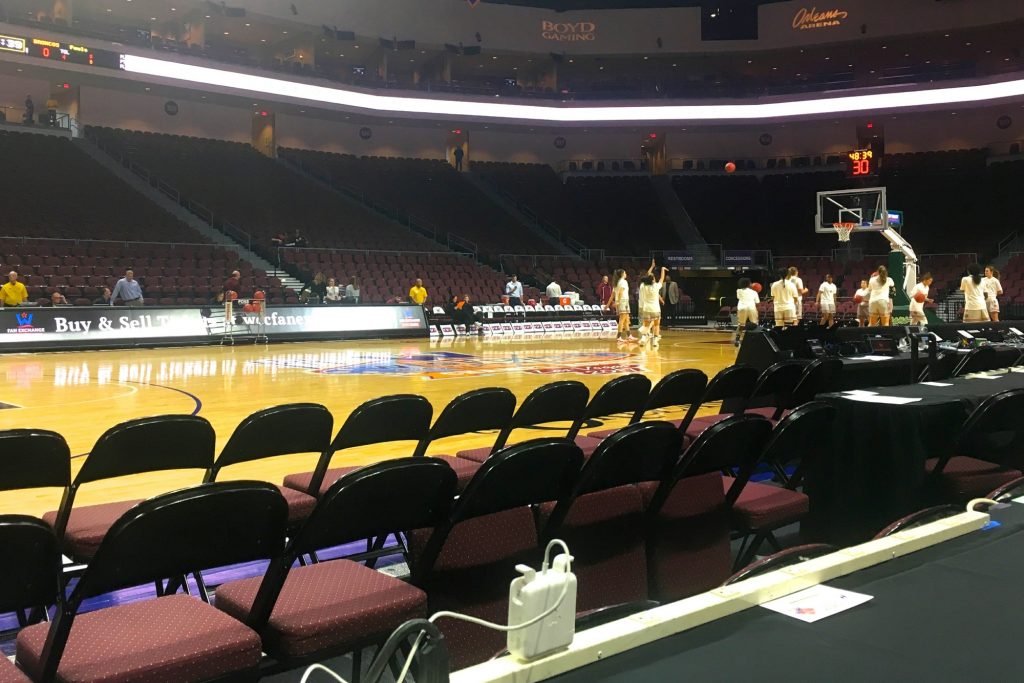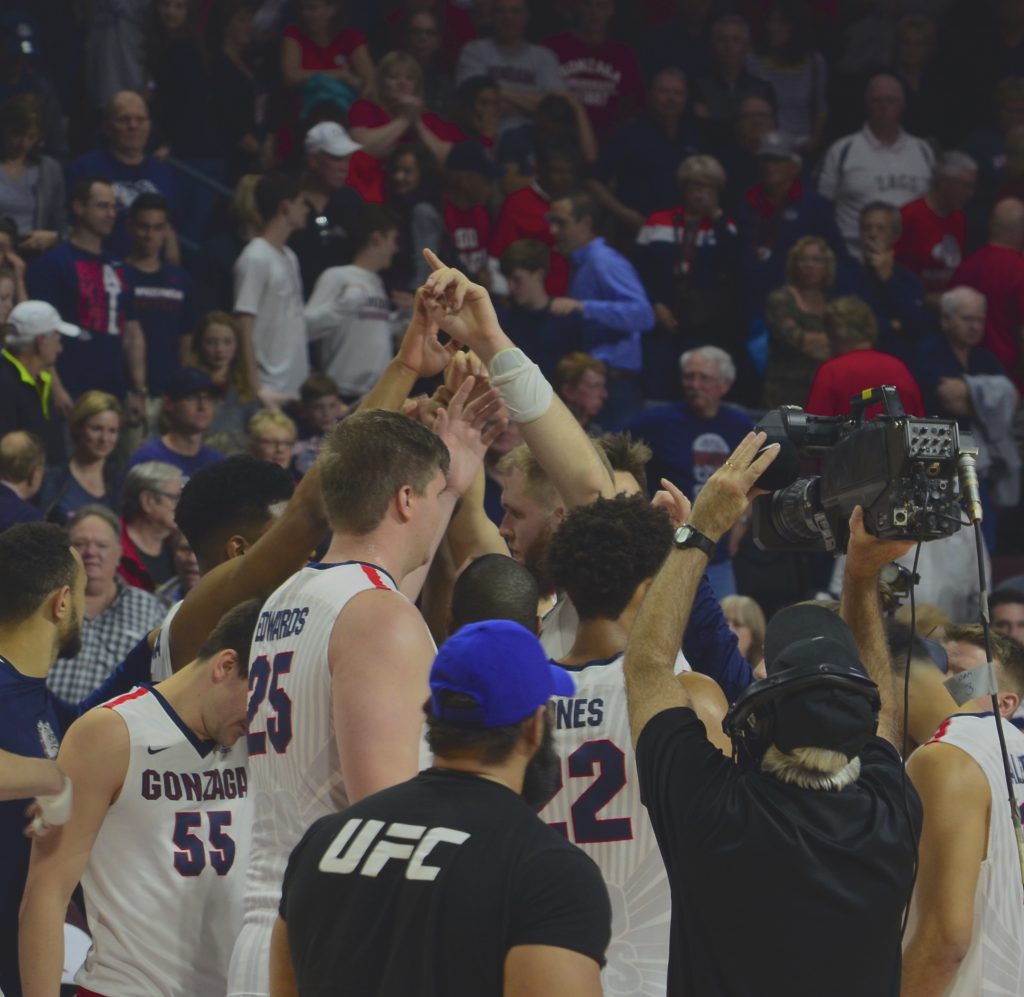Photos by Kyle Cajero
My first memory of watching the West Coast Conference Tournament occurred two years ago during spring break. Even though my freshman house won an all-expenses paid trip to Las Vegas to see Pepperdine play in the conference tournament, I was unable to join my freshman house because I had a track meet at UNLV. Graciously, my coach decided to take the team to Pepperdine’s quarterfinal game against USD after our meet ended.
Freshman me would’ve laughed at the notion of trading my track spikes for a media placard for the WCC from the sidelines. Yet here I was — fifteen feet from the baseline, with a media pass and my family’s DSLR camera around my neck — experiencing something I never thought I would. The twelve opening round games I watched in the WCC Tournament not only provided an experience of a lifetime, but also also reaffirmed my career aspirations (or to use a Pepperdine buzzword, my vocation).
Being the youngest person on press row at the WCC Tournament was both thrilling and terrifying. On one hand: I was the only credentialed media member who couldn’t legally drink.
On the other hand: I had the least amount of journalistic experience, the smallest audience and was probably not even the most capable and qualified sportswriter on The Graphic’s Team Sports staff. I questioned my qualifications several times throughout the tournament: Did someone make a mistake? Did I really deserve a press pass? The self doubt combined with the excitement of the tournament — four of the six men’s match-ups and two of the women’s were single-digit games— made me the most nervous reporter in Las Vegas.
My naiveté showed on the first day. Between the action of the women’s first-round games, I frantically drafted interview questions, prepared notes and sifted through stats for Men’s Basketball’s first-round game against Pacific. Halfway through preparing my recap article for later that evening, I errantly glanced at the bracket on the back wall of the media lounge. My heart skipped a beat — and not because of the free, unlimited coffee from the media lounge — as I realized my mistake. My stomach dropped. The room started to spin. I was Krabs-memed.
I showed up to the men’s game against Pacific a day early.
Granted, there aren’t many things for a 20-year-old to do in Las Vegas — especially a scrawny, awkward, boyish looking 20-year-old like me. Plus, I had already gone to all the record stores I planned to, so I didn’t have anything else I wanted to do. But instead of dwelling on my embarrassing snafu, I opted to take advantage of the moment: I took my place on press row, pulled up the live stats feed and watched WCC Women’s Basketball for the first time this season.
Saint Mary’s and Santa Clara squared off for my first game on a half-full press row. Most games in the early rounds of the WCC Tournament weren’t anywhere near capacity, which was a relief. Three years of watching Pepperdine basketball games has conditioned me to think a half-empty stadium is normal. Sometimes it was so quiet that I could hear players bark out plays, referees remind players and — on more than one occasion — coaches yelling during timeouts.
Unlike the play-in games earlier that afternoon, the Broncos gave the higher-seed Gaels a scare. The teams traded leads 15 times and were tied for 6:15 out of a possible 40 minutes of play. I reminded myself that close games in conference tournaments were the norm; the neutral court, familiarity between the opponents and shorter rest in the later rounds tend to even the playing field.
Several minutes before the tipoff of the USD-LMU quarterfinal, I had some unexpected visitors on press row. A woman in her late thirties rested her iPad on the table and took a seat on my left. A middle-aged man took out a pad of paper and took notes about the game to my right. They didn’t have press passes, but they were very knowledgable; throughout the game, the woman would point out offensive and defensive schemes, while the man would point out fouls and good moves from certain players on the court.
After the third or fourth time the woman tried to get the man’s attention, the man gestured to an empty seat to his right and said, “Are you sure you don’t want to sit here?”
“I’m fine, Jordan,” she said, and then nudged me, “I like this guy.”
Since I live in a perpetual state of discomfort, I could only muster a nervous chuckle.
During a media timeout in the second quarter, a promo video about the WCC all-conferene awards played on the jumbotron. Since I knew next-to-nothing about WCC women’s basketball, I looked up at the screens and paid attention.
As soon as the WCC Women’s Coach of the Year appeared on the screen, I had a realization: I was sitting with the (eventual WCC Tournament Champions) Gonzaga women’s basketball coaching staff — including WCC Women’s Coach of the Year Lisa Fortier.
For those keeping score: Me — a good, nervous little boy covering a basketball tournament for the first time — was sitting next to two people who had more basketball IQ in one cell of their bodies than I’ve ever had in any of my articles combined.
<blockquote class=”twitter-tweet” data-lang=”en”><p lang=”en” dir=”ltr”>Things I never thought I'd tweet: Watching the WCC Women's Basketball Tournament with the Gonzaga coaching staff has been a blast.</p>— Kyle Cajero (@kylecajero) <a href=”https://twitter.com/kylecajero/status/837800985078583296″>March 3, 2017</a></blockquote> <script async src=”//platform.twitter.com/widgets.js” charset=”utf-8″></script>
I was floored. And to think this was only the first day.
In fact, I enjoyed watching the women’s games so much, that I arrived several hours early the following day to watch two women’s quarterfinals games.
I finally got to see Fortier and Jordan Green’s gameplans in action. Their Bulldogs handled the plucky Pacific Tigers with a convincing 32-point win. Like the previous day, the coaches rejoined me on press row to scout out the BYU-USD game.
“Oh no, not you again.” Fortier said with a smirk as she and Green took their same seats for what would be one of the best games of the tournament.
Led by the defense and offensive playmaking abilities of senior guard Cori Woodward, the seventh-seeded Toreros (or would it be Toreras?) outscored the Cougars 21-7 in the first quarter. Nothing was falling for the Cougars, except senior guard Mackenzi Pulsipher, who fell on the ground more times than BYU had points in the first quarter.
The Gonzaga coaches had some choice words to say about her tendency to flop; I’ll leave it at that.
Despite the USD’s impressive start, the underdogs lost momentum in the second half. BYU senior guard Cassie Broadhead showed up in the second half, and proved to the crowd why she was the WCC Player of the Year.
Her signature moment came in the waning moments of regulation. Facing a three-point deficit, the Cougars inbounded the ball in front of their own bench with 21 seconds left. Everyone knew what was coming: Broadhead was going to make the three and send the game into overtime.
<blockquote class=”twitter-tweet” data-lang=”en”><p lang=”en” dir=”ltr”>Here's the 3 from <a href=”https://twitter.com/byuwbb”>@byuwbb</a>'s <a href=”https://twitter.com/CBroadway20″>@CBroadway20</a> that sent the game into OT � <a href=”https://t.co/PNGDJBB0bW”>pic.twitter.com/PNGDJBB0bW</a></p>— TheW.tv (@TheWtv) <a href=”https://twitter.com/TheWtv/status/837816396071350272″>March 4, 2017</a></blockquote> <script async src=”//platform.twitter.com/widgets.js” charset=”utf-8″></script>
Of course the Cougars ended up winning in overtime.
As the kids would say, I was shook because of this game. Then the Pepperdine game happened.
My lasting image of the West Coast Conference tournament is of Lamond Murray making a cut past the three-point line with less than 20 seconds to play.
After three-hundred sixty-five minutes of basketball over the course of three days, my most vivid image is of Murray moving on the court. Not scoring one of his 41 points. Not sitting in the postgame press conference, realizing he had his last college game with his fellow seniors.
Whenever Murray Jr. moves on the court, he glides — but not like an insect gliding on the surface of a pond. He glides like a manta ray. He’s rarely tentative, always fluid and, to echo what Head Coach Marty Wilson said afterwards in the postgame press conference, “I would not want to guard him.”
Watching Murray turn on the jets on the court is like watching a Lamborghini Aventador cruise into the rear view mirror while driving along PCH. Something’s going to happen, and whatever it is, it’s going to be bold. It’ll be impressive.
Pepperdine needed something impressive to own two possessions with merely seconds to spare, so they drew up the best play they could: Get the ball to Murray.
I can picture Murray coming off of a screen from senior walk-on Kevin Hempy. Murray is bolting towards the left elbow, well behind the three-point line. Fellow senior and Pepperdine’s all-time assist leader Jeremy Major is running the point at the top of the key. Major’s going to swing it to Murray for three.
The ending was far too familiar for people who have stuck with Pepperdine basketball this season. Murray missed, the Waves took too much time setting up another desperation heave and the last-ditch effort ended in a turnover.
Season over.
Although one could argue Pepperdine’s chances of winning evaporated when freshman forward Nolan Taylor fouled out with 5:02 remaining, this moment with 18.5 seconds left was the final straw. Granted, tying the game would require something close to a miracle even if Murray pulled the Waves within one possession. Pepperdine would have to call a timeout to implement a press, then force a turnover and score on the ensuing possession — oh, and all of that would have to happen in approximately 17 seconds.
Yet for a night, it seemed like Murray and Major could will their Waves team to the next round. The stars aligned: Murray had the best Pepperdine performance of the decade, the seniors scored the Waves’ final 12 points and Pacific was a beatable team. In the moments after the game, I realized how much that close loss hurt; I even convinced myself that the first-round loss to Pacific would’ve been worse than the impending evisceration from the No. 4 Gonzaga Bulldogs in the next round. At least this game was winnable.
But I knew I couldn’t get too sentimental and caught up in the pain of defeat. As a member of the press, I was required to cover the game, which would involve getting player and coach quotes from the postgame presser. I had to prove I was a worthy recipient of a press credential (not to mention the free parking, admission, statistics and endless food in the media lounge).
Besides, there would be more basketball to watch tomorrow.
__________________________
Follow Kyle Cajero on Twitter: @kylecajero






